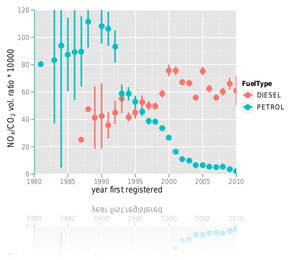
It has become clear in the last year or so that concentrations of oxides of nitrogen (NOx) and of nitrogen dioxide (NO2¬), the harmful component of NOx, in the ambient atmosphere have not been reducing over the past 5-6 years or more. This is in contrast to the downward trend calculated by emission inventories based on the expected improvements in emission performance of road vehicles (the main source of NOx in urban areas). Legal limits for emissions from road vehicles have been tightened periodically since the 1970s in the so-called ‘Euro standards’ for cars, light vans and heavy duty vehicles. The big improvement came in 1993 when the latest tightening of limits required the use of catalytic converters on petrol cars. These devices can reduce harmful emissions of carbon monoxide, NOx and VOCs (volatile organic compounds, a group of pollutants including human carcinogens like benzene) by over 95% when the catalyst has reached its operating temperature. In the early 1990s petrol cars dominated the car fleet and urban levels of these pollutants fell significantly. However, since about 2004, levels particularly of NOx and NO2 have remained broadly constant in urban and traffic locations and in some places have even begun to increase.
So why has this happened? This is the subject of a recent study funded by Defra and led by Dr David Carslaw, supported by Sean Beevers, Emily Westmoreland and Martin Williams at King’s, along with colleagues from AEA and the University of Leeds. From measurements of emissions from vehicles in real-world conditions using a remote sensing technique developed in the USA which samples thousands of cars per day, and other emission measurements in real driving conditions elsewhere in Europe, it became clear that the emissions of vehicles in day-to-day driving conditions in cities-particularly diesel cars - have not been decreasing in line with the increasingly stringent legal limits. So does this mean there are thousands of illegal cars on the road? No, it simply means that the standard legal emission test is flawed and does not test all types of driving condition. Diesel cars therefore pass the legal test but emit differently in real-world use. This has meant that actual emissions of NOx from diesel cars have not improved in the last 10-15 years or so. The study also showed that emissions of HGVs remained roughly static until the Euro IV standard when around 2007 they began to fall. Bus NOx emissions on the contrary appear to have remained broadly constant, or even increased, over the past 10-15 years. What’s more, the use of so-called oxidation catalysts and other similar treatments of diesel exhaust to remove harmful particles (soot) from the exhaust, has led to an increase in the fraction of the NOx which is emitted as the harmful NO2 and for which the UK is failing to meet the EU legal limit in air.
Is this a peculiarly UK problem? No, it goes Europe-wide-unsurprisingly as all EU cars have to meet the same limits and use broadly the same technologies. What can be done? The study suggest some policy measures which can help. Firstly to correct the problem in the future, the regulatory test cycle needs to be changed; discussions on the cycle are under way in an international committee in Geneva. The problem for the present however is that there are a large number of diesel cars in the fleet which are emitting more NOx than was expected; hence any policies which encourage the removal of these cars from the fleet would be beneficial - incentivising new petrol cars or even better, hybrids for example would help. So too of course would measures to reduce overall mileage and car use. Defra are seeking comments by 1 April on the paper which can be found at the link below.
Item date 18/03/2011
Follow Us
Our newsletter
 Privacy Notice Summary:
Privacy Notice Summary:
- Who this is for: You must be at least 13 years old to use this service.
- What we collect: We store your email address
- Who we share it with: We use "Campaign Monitor" to store it, and do not share it with anyone else.
- More Info: You can see our full privacy notice here
AirMail newsletter
The latest news and research from ERG: View the archive

